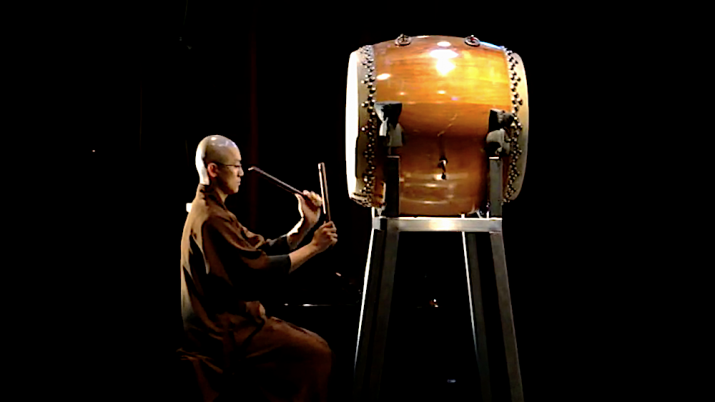NEWS
Research Confirms the Health Benefits of Drum Meditation
 From youtube.com
From youtube.comAs perhaps the most primal of all musical instruments, the drum has been central to many religious and cultures throughout human history—from shamanism, where documented use of the drum dates back more than 25,000 years, to medieval Catholic rituals, to the various traditions of Buddhism. For the last 2,500 years, from the time of the historical Buddha, Shakyamuni, to the present, drums have been an important component of Buddhist practice in temples and monasteries, where they are still used to this day, from the most mundane time-keeping and time-marking tasks to deep meditative practice.
In the words of Canadian sound therapist Gary Diggins: “We moderns are the last people on the planet to uncover what older cultures have known for thousands of years: The act of drumming contains a therapeutic potential to relax the tense, energize the tired, and soothe the emotionally wounded.” (Psychology Today)
Clinical research on humans has documented a multitude of significant therapeutic benefits from drumming, from helping with memory loss, stress reduction, and boosting the immune system, to treating depression and as a supportive adjunct for cancer treatment. Among them:
1. Reduced blood pressure and anxiety: a 2014 study published in Journal of Cardiovascular Medicine.
2. Improved cognitive function and physical changes in the brain: a 2014 study published in Journal of Huntington’s Disease.
3. Elevated pain tolerance: a 2012 study published in Evolutionary Psychology.
4. Reduced stress and cortisol levels: a 2001 study published in the journal Plos One.
5. Combined with shamanistic instruction, decreased heart rate and dreamlike experiences consistent with transcendental experiences: a 2014 study published in Plos One.
6. Improved socio-emotional behavior in disadvantaged children: a 2001 study published in Evidence-Based Complementary and Alternative Medicine.
And while the benefits of mindfulness meditation are well documented within the teachings of Buddhism and lately within the modern Western mindfulness movement, perhaps less widely known is the application of drumming as a mindfulness practice.
In the Mahayana tradition, drums and bells are regularly used to announce the daily meditation or to make offerings. Drums, bells, and gongs are also used to accompany sutra recitation—to focus the mind, to give thanks, and to purify. The use of drums as a mindfulness aid to focus attention is also well established in Zen Buddhism; the wooden fish drum is a well-known device for marking time during sutra chanting. In Korea and Japan, drumming performances by Buddhist monks have become an art form and a particularly intense form of meditation requiring near trance-like intensity and mindful focus.
In Vajrayana Buddhism, the drum and bell are also symbols potent with significance. The bell, representing the wisdom of “emptiness" and the drum expressing “bliss” are used extensively in rituals. Symbolically, sound reaches out to sentient beings in all realms of existence—in the spiritual practice of Chöd (also known as Cutting through the Ego) the sound of the drum, accompanied by a small bell, is said by some to be the voice of the dakinis, carrying blessings and helping to propel meditation visualization.
One of the most appealing aspects of drumming—as a religious practice, a meditative tool, a therapeutic aid, or as simple entertainment—is its simplicity. It can be performed in almost any attitude in which the practitioner feels comfortable: sitting, standing, even dancing. And it demands no special equipment. If a drum isn’t available, many objects can provide an effective substitute—a bucket, Tupperware, a box, even a pillow if the circumstances dictate. Used in place of the breath as a tool of mindfulness, the trance-like effect of drumming provides a point of focus that is difficult to ignore and can help to still even the most monkey-like of minds.
“I beat upon the Dharma drum, announcing my search for Dharma in the four directions” — Lotus Sutra, Chapter 12
See more
Drumming for mindfulness and healing: a simple way to calm the mind, remove stress and heal. Studies show drum meditation supports treatments of cancer, Parkinsons and depression (Buddha Weekly)
The Heart is a Drum Machine: Drumming as Therapy (Psychology Today)
6 Ways Drumming Heals Body, Mind and Soul (Green Med Info)
Buddhist Drumming (YouTube)














